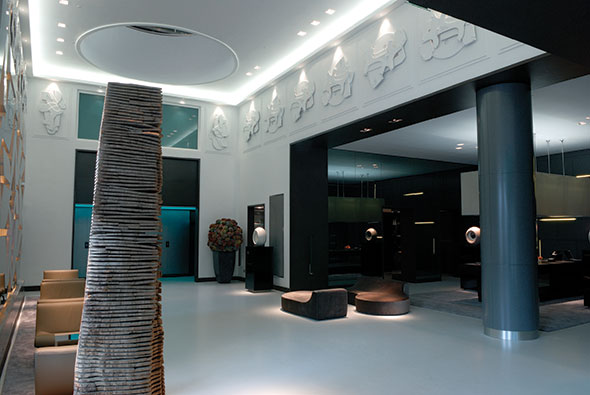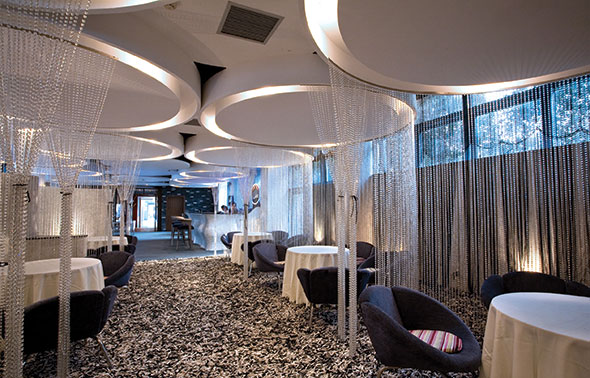The Mansion, Amsterdam
With a solid wink to the fin de siècle opulence of A’dam’s histoire, The Mansion, which set up shop in one of the Dutch royal family’s historic residences a few years ago, manages to cram glittering chandeliers and gilt-edged mirrors into a space that routinely throbs with house DJ mega mixes. It’s a club, a bar and a restaurant, the idea being that you’ll spend all your nightlife Benjamins in the same establishment. With three floors and multiple rooms to show off in, the designers went wild with frescoed ceilings, red lighting and mirrored everything. (Because looking at oneself is always in fashion.)
The mood at The Mansion gets progressively sinister as you move from the entrance with its giant black and white photo of Frank Sinatra and Marilyn Monroe, through the shiny, sparkly dining room and three Rococo cocktail bars, to the basement club. The downstairs space, which was purportedly inspired by The Cotton Club, looks more like a different Marilyn’s idea of party-ville (hint: Manson). While dark-red lighting is nothing new in club land, subtle details such as old-fashioned lampshades make for stunning effects.
To a town that’s learning to drag its reputation, if not up from the gutter, than at least out of the coffee shop, The Mansion has added a healthy dose of glamour. Don’t forget to pack sunglasses so that after a long night you can make your way past all those mirrors with vanity intact. Hobbemastraat 2, Amsterdam. www.the-mansion.nl
The Gramercy Park Hotel, New York
Drama, celebrity, suicide! For a truly enviable hotel experience it helps if one can wax prosaic on more than just thread count and spa treatments. Throw in a handful of art stars and management/landlord scuffles and you might be talking about the history of the storied Hotel Chelsea. Add a velvet rope or two and some really expensive rooms, however, and the search narrows to the recently restored grand dame of NYC hotels, The Gramercy Park Hotel.
Once the permanent residence of bold-facers Bogart, Cagney and err… Paul Shaffer, The Gramercy lost its luster in the late ’90s, and while the rooftop bar and dusty piano lounge with free bowls of Goldfish and cheap drinks made for kitschy fun, a makeover was more than needed.
Enter super-hotelier Ian Schrager, in collaboration with pajama-clad Renaissance maestro, Julian Schnabel, who brought in style by the truckload. Warhol and Basquiat prints line the lobby and bar and the walls shimmer with luxurious fabrics and colors, and even though you are drinking a $25 cocktail, the feel of bygone bohemia lingers in your
peripheral vision.
For those who can’t bear to depart, tastefully designed luxury residences and hotel rooms share the upper stories. Since humans in the early twentieth century weren’t as concerned with squeezing every ounce of value out of a square foot of space, the rooms at The Gramercy are roomy, which allowed Schnabel and his crew to go for the bold. Footstools and wing back armchairs in luxurious Raphael-inspired color palettes mix with contemporary art and heavy velvet drapery. As befitting a five-star establishment, each of the 185 rooms is unique. The residences next door at 50 Gramercy Park North are another story—there modernism does reign, and sleek loft units are in stark contrast to the opulence of its neighbor. Bravo, Mr. Schrager. 2 Lexington Ave, New York. www.gramercyparkhotel.com

Andaz, London (pictured above)
London’s Great Eastern Hotel was the epitome of hipster chic and brought much needed cool to the city earlier this decade. It certainly helped that the actual hotel experience (you know, eating, drinking and sleeping) was accompanied by random art installations and performances from the likes of Damien Hirst and Tricky. Well, cherish those memories because last winter the former Terence Conran property changed hands and is now one of Hyatt’s Andaz branded five-star boutiques.
The design of the Andaz is a little more subdued than was the GE, but Hyatt certainly hasn’t gone all corporate on us. (Don’t forget that Hyatt’s San Francisco property was at the forefront of hotel design in the ’70s.) Working around the concept of casual luxury, which trumpets one-on-one service, there is no check-in desk or concierge station, so the downstairs design resembles a living room more than hotel lobby.
From the lobby you can stroll into the more classically designed pub, The George, with its tall wooden stools and tables, or up though the neon-lit atrium to your room, which is modernism personified with its wi-fi docking station and bold color scheme.
Certainly ‘tasteful’ and ‘unobtrusive’ are themes here, but glimmers of cheek appear in the details, like the flush steel elevator doors and an Apple Store-like “guest relations desk.” And of course the Andaz’s modern design incorporates an eco-conscious attitude, which means less water for the loo but hopefully not less tonic for the gin. 40 Liverpool St.,London. www.andaz.com
Dolce & Gabbana Gold, Milan
“No Mr. Bond, I expect you to die.” With those icily delivered words Auric Goldfinger cemented his reputation as one of 007’s most notorious nemeses, along with Dr. No and that guy with the metal teeth. There’s no question that gold was a capital object for Ian Fleming to mold a Bond tale around. Gold has held more men and women in its sway than say, lint, and of course the gold standard monetary system lends a certain cache.However, numismatic considerations were probably less of an issue than good old-fashioned shininess and color when Italian design stars Domenico Dolce and Stefano Gabbana created their shrine to “Au.” Dolce & Gabbana Gold, the Milanese restaurant/lounge/café, literally oozes gold in all forms, from the embroidery on the napkins to the candleholders and bar stools. Even the to-go bags, which diners can fill with post-meal purchases of even more wine and desert, are of the chicest gold design.
With Gold, the fabulous duo added to their already sizeable empire—Milan has four stores, a spa and a barber shop that bear blinged-out D&G logos—and the addition of a restaurant and event space has given the brand yet another delightful venue with which to wow the glitterati. We can imagine that at least one celebrity hipster showed up at the D&G Fall Fashion Show after-party sporting gold sneakers. Via Carlo Poerio 2/A, Milan. www.dolcegabbanagold.com

HOMA, Guilin (pictured above)
There’s no doubt that the ‘emerging nations,’ as they have been dubbed, are well on their way to emerging the good ‘ole US of A right off the map in the not too distant future. Sure, beautiful breezy Beijing (to steal a line from 30 Rock) is still working on that pesky solid air issue, but the fire under their ass that was the Olympics resulted in some of the most stunning new architectural designs this year, and we’ve no doubt that the Chinese work ethic wont be taking a day off any time soon. Expect more and better.
All this new design makes the five-year-old HOMA, or Hotel of Modern Art, in Guilin a relative institution of forward-thinking exuberance, but it is only recently that it has gotten its due from the West with numerous accolades and write-ups this year. HOMA is comprised of two completely unique hotels situated on the grounds of a modern park that showcases over 200 works of sculpture and art.
Of the hotels, the HOMA Libre is the boutique, with 46 individually designed rooms that are all air, light and bamboo. The hotel itself is tucked into the surrounding landscape and thanks to its grass-covered roof, can disappear into its environment from certain angles. While the HOMA Sutra is a larger hotel and is geared more to corporate getaways and conventions, it doesn’t skimp on stylish design. The rooms are gorgeous in their simplicity and the exterior of this ‘marble lined tone poem’ is decorated with a bar code rendition of the Buddhist Heart Sutra. Take that, American corporate convention hotel. Yanshan District, Guilin, China.
TEXT BY Adam Pollock

